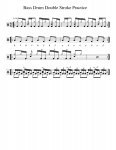Hey so I've been working on my bass drum speed, which is definitely a weak area of mine (I've been playing around 10/11 years).
When it comes to hammering out constant eights for example, I've realised I need to get less leg motion and more of a pivot on the heel. My problem is, when I lift my heel and then play constant notes, I very quickly fatigue in my upper leg area, specifically where the leg meets the hips.
I don't know if I'm tensing up in that area too much, or it's a case of the muscle just being weak. But it's the weight of lifting my heel up, feels like I'm now supporting my entire leg's weight on just that groin area in order to hold my heel up from the pedal.
This has been something I have noticed and had issue with for YEARS so I'm not really sure if it's a case of the muscle being built up as I'd assume that would have happened by now.
I'm not sure if it's a technique issue or a stamina issue
Any ideas? cheers!
When it comes to hammering out constant eights for example, I've realised I need to get less leg motion and more of a pivot on the heel. My problem is, when I lift my heel and then play constant notes, I very quickly fatigue in my upper leg area, specifically where the leg meets the hips.
I don't know if I'm tensing up in that area too much, or it's a case of the muscle just being weak. But it's the weight of lifting my heel up, feels like I'm now supporting my entire leg's weight on just that groin area in order to hold my heel up from the pedal.
This has been something I have noticed and had issue with for YEARS so I'm not really sure if it's a case of the muscle being built up as I'd assume that would have happened by now.
I'm not sure if it's a technique issue or a stamina issue
Any ideas? cheers!




